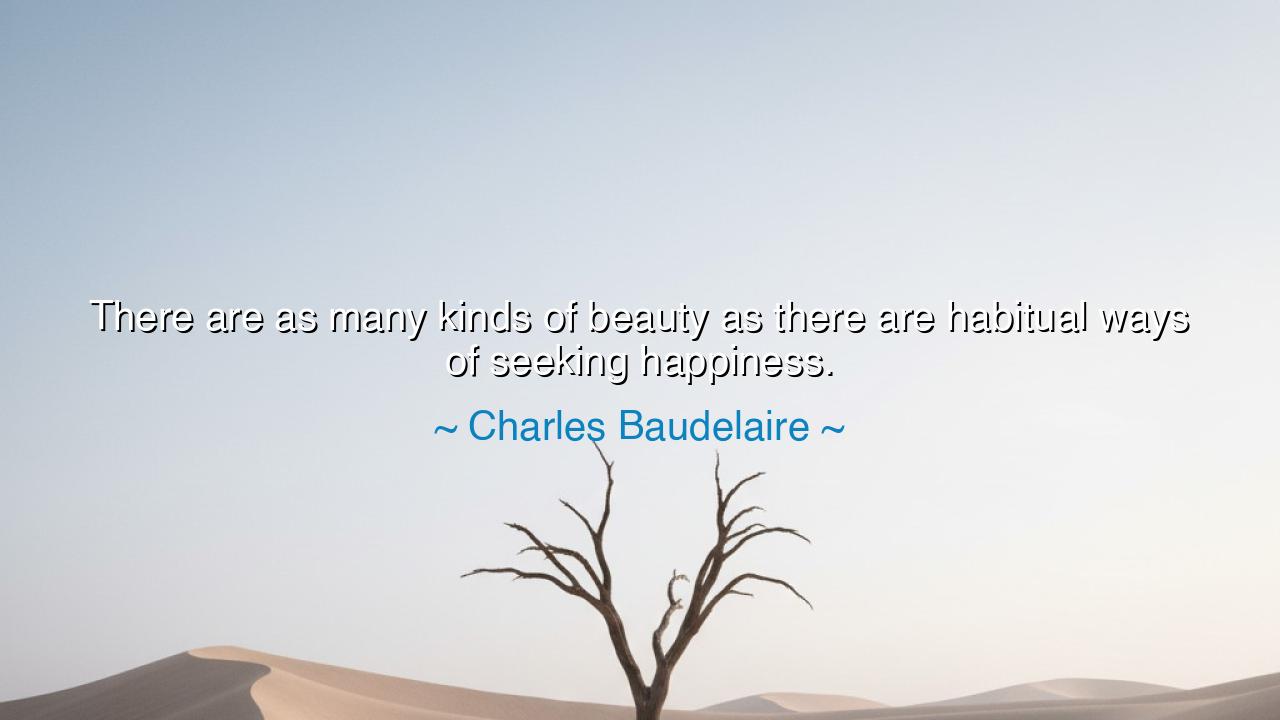
There are as many kinds of beauty as there are habitual ways of






In the hauntingly elegant words of Charles Baudelaire, the poet of shadows and splendor, he once wrote: “There are as many kinds of beauty as there are habitual ways of seeking happiness.” These words, like a whisper from eternity, remind us that beauty is not a fixed thing carved into the world, but a reflection of the heart that beholds it. Each soul, in its endless journey toward happiness, fashions its own image of what is beautiful — for what the spirit seeks, the eye learns to adore. Thus, beauty and happiness are not strangers to one another, but twin flames, each revealing the shape of the other.
To understand Baudelaire’s insight, one must first see him not only as a poet, but as a seeker — a wanderer through both ecstasy and despair. Living amid the decay and splendor of 19th-century Paris, he saw how men pursued happiness in countless ways: through art, through love, through wine, through dreams, through the contemplation of the divine. Each of these pursuits, he observed, created its own beauty, born from the soul’s desire. For the one who finds peace in prayer, beauty dwells in silence and faith; for the artist, it burns in color and motion; for the lover, it shines in the face of the beloved. And for the wanderer who finds solace in melancholy, even the dying leaf becomes a masterpiece. Beauty, therefore, is not an object — it is a mirror of the inner life.
The ancients, too, understood this. The philosopher Plato taught that beauty was the visible face of the Good — that every heart’s longing for happiness was, in truth, a longing for harmony with the eternal. Yet, as Baudelaire reveals, the path to harmony takes infinite forms, for no two hearts seek in the same way. Some are drawn to simplicity, others to grandeur; some find joy in the laughter of children, others in the stillness of solitude. The peasant who delights in the soil, the musician who weaves emotion into melody, the scholar who finds truth in thought — each discovers a beauty that matches his own pursuit. Thus, the diversity of human happiness gives birth to the diversity of beauty in the world.
Consider the life of Vincent van Gogh, the tormented artist who saw beauty where others saw only desolation. In the barren fields and the lonely stars, he found not despair, but the trembling presence of the divine. His way of seeking happiness — through creation, through color, through the intensity of vision — shaped his world into something luminous and eternal. Others might have found peace in comfort or fame, but van Gogh’s beauty was born of his struggle to find joy amid pain. Through him, Baudelaire’s words come alive: each person’s habitual way of seeking happiness gives rise to a unique expression of the beautiful, a fingerprint of the soul upon the face of existence.
In this, there is a sacred lesson: that to understand another’s beauty, one must first understand their happiness. We live in a world eager to define what is lovely — to decree which faces, which art, which dreams are worthy of admiration. Yet Baudelaire teaches us that beauty is as plural as humanity itself. What moves one heart may leave another untouched; what brings tears of joy to one soul may seem incomprehensible to another. The wise do not seek to judge, but to perceive — to look upon the world with gentler eyes and recognize that each person’s vision of beauty is the language of their longing.
The poet’s words also hold a quiet warning. For just as there are infinite forms of beauty, there are also many false paths to happiness. When the heart seeks its joy in greed, vanity, or cruelty, the beauty it creates becomes corrupted — hollow, dazzling, yet lifeless. True beauty springs from sincerity, from a pursuit aligned with the soul’s higher nature. It is found not in perfection, but in authenticity — in the face that smiles from compassion, in the hand that labors for love, in the eyes that see wonder even in suffering. The art of life, then, is not merely to seek happiness, but to seek it rightly, so that the beauty we create becomes a light to others and not a shadow.
Let this, then, be the teaching passed down: each person must learn to discover beauty through the path of their own becoming. Ask not where beauty lies, but where your joy leads you — for where your happiness lives, there too will your beauty bloom. Cultivate your inner world, nurture what is pure and true, and the world around you will mirror that radiance. See in every person a different song of the same symphony — every face, every dream, a reflection of the eternal dance between joy and creation.
Thus, the teaching concludes: Charles Baudelaire, who walked through both the light and the darkness of human experience, reminds us that beauty is not a single star in the heavens, but the entire constellation of human seeking. Wherever there is genuine striving toward happiness, beauty is born. So live in such a way that your pursuit — your work, your love, your hope — gives rise to something radiant. For in the end, the world’s infinite kinds of beauty are nothing more than the many ways the human heart remembers how to be happy.






AAdministratorAdministrator
Welcome, honored guests. Please leave a comment, we will respond soon